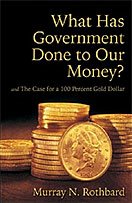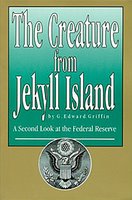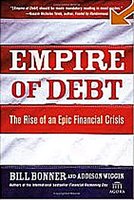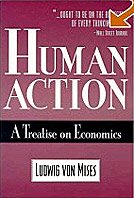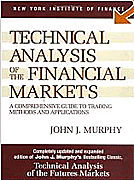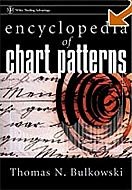Oikonomika Blog
* In Aurum Securitas *
Modern economics is not rocket science.
In fact, it's not science at all. It's a game, a confidence game.
Once paper passed for money, economics became an elaborate
shell game designed to hide the fact paper had been substituted for silver and gold.
The shell game is called "Where's The Money?"...
The answer is simple, it's not there.
Sep 17, 2011
May 24, 2011
Apr 9, 2011
Impeach Bernanke! - An open letter to Congressman Ron Paul of Texas
Labels: Antal Fekete, FED, fiat money
Nov 13, 2010
Jan 9, 2010
Dec 8, 2009
Nov 23, 2009
Orlandini doesn't mince his words when it comes to the credit crisis
Labels: Enrico Orlandini, FED, financial crisis
Sep 28, 2009
Declassified 1975 Fed memo explains need for gold price manipulation!
Fed Arthur Burns on Gold 6 3 1975
Labels: FED, market manipulation
Sep 23, 2009
GATA: Fed admits hiding gold swap arrangements
The Federal Reserve System has disclosed to GATA that it has gold swap arrangements with foreign banks that it does not want the public to know about.
The disclosure contradicts denials provided by the Fed to GATA in 2001 and suggests that the Fed is indeed very much involved in the surreptitious international central bank manipulation of the gold price particularly and the currency markets generally.
The Fed's disclosure came this week in a letter to GATA's Washington-area lawyer, William J Olson of Vienna, Virginia (http://www.lawandfreedom.com/), denying GATA's administrative appeal of a freedom-of-information request to the Fed for information about gold swaps, transactions in which monetary gold is temporarily exchanged between central banks or between central banks and bullion banks. (See the International Monetary Fund's treatise on gold swaps here: http://www.imf.org/external/bopage/pdf/99-10.pdf.)
The letter, dated September 17 and written by Federal Reserve Board member Kevin M. Warsh (see http://www.federalreserve.gov/aboutthefed/bios/board/warsh.htm), formerly a member of the President's Working Group on Financial Markets, detailed the Fed's position that the gold swap records sought by GATA are exempt from disclosure under the U.S. Freedom of Information Act.
Warsh wrote in part: "In connection with your appeal, I have confirmed that the information withheld under Exemption 4 consists of confidential commercial or financial information relating to the operations of the Federal Reserve Banks that was obtained within the meaning of Exemption 4. This includes information relating to swap arrangements with foreign banks on behalf of the Federal Reserve System and is not the type of information that is customarily disclosed to the public. This information was properly withheld from you."
When, in 2001, GATA discovered a reference to gold swaps in the minutes of the January 31-February 1, 1995, meeting of the Federal Reserve's Federal Open Market Committee and pressed the Fed, through two U.S. senators, for an explanation, Fed Chairman Alan Greenspan denied that the Fed was involved in gold swaps in any way. Greenspan also produced a memorandum written by the Fed official who had been quoted about gold swaps in the FOMC minutes, FOMC General Counsel J. Virgil Mattingly, in which Mattingly denied making any such comments. (See http://www.gata.org/node/1181.)
The Fed's September 17 letter to GATA confirming that the Fed has gold swap arrangements can be found here:
http://www.gata.org/files/GATAFedResponse-09-17-2009.pdf
While the letter is far from the first official admission of central bank scheming to suppress the price of gold (for documentation of some of these admissions, see http://www.gata.org/node/6242 and http://www.gata.org/node/7096), it comes at a sensitive time in the currency and gold markets. The U.S. dollar is showing unprecedented weakness, the gold price is showing unprecedented strength, Western European central banks appear to be withdrawing from gold sales and leasing, and the International Monetary Fund is being pressed to take the lead in the gold price suppression scheme by selling gold from its own supposed reserves in the guise of providing financial support for poor nations.
GATA will seek to bring a lawsuit in federal court to appeal the Fed's denial of our freedom-of-information request. While this will require many thousands of dollars, the Fed's admission that it aims to conceal documentation of its gold swap arrangements establishes that such a lawsuit would have a distinct target and not be just a fishing expedition.
In pursuit of such a lawsuit and its general objective of liberating the precious metals markets and making them fair and transparent, GATA again asks for your financial support and that of all gold and silver mining companies that are not at the mercy of market-manipulating governments and banks. GATA is recognized by the U.S. Internal Revenue Service as a non-profit educational and civil rights organization and contributions to it are federally tax-exempt in the United States. For information on donating to GATA, please visit here:
http://www.gata.org/node/16
You can also help GATA by bringing this dispatch to the attention of financial news organizations and urging them to investigate the Fed's involvement in gold swaps particularly and the gold (and silver) price suppression schemes generally.
CHRIS POWELL, Secretary/Treasurer
Gold Anti-Trust Action Committee Inc.
Sep 11, 2009
Richard Russell: Fed will do anything to keep gold down
Labels: FED, market manipulation, Richard Russell
Sep 8, 2009
Orlandini: We're heading into a long, cold and grim winter...
Labels: depression, economic crisis, Enrico Orlandini, FED
Sep 5, 2009
Ron Paul: End the FED
End the Fed

Most Americans haven't thought much about the strange entity that controls the nation's money. They simply accept it as though it has always been there, which is far from the case. Visitors to Washington can see the Fed's palatial headquarters in Washington, D.C., which opened its doors in 1937. Tourists observe its intimidating appearance and forbidding structure, the monetary parallel to the Supreme Court or the Capitol of the United States.
People know that this institution has an important job to do in managing the nation's money supply, and they hear the head of the Fed testify to Congress, citing complex data, making predictions, and attempting to intimidate anyone who would take issue with them. One would never suspect from their words that there is any mismanagement taking place. The head of the Fed always postures as master of the universe, someone completely knowledgeable and completely in control.
But how much do we really know about what goes on inside the Fed? With the newest round of bailouts, even journalists have a difficult time running down precisely where the money is coming from and where it is headed. From its founding in 1913, secrecy and inside deals have been part of the way the Fed works...
..To read Ron Paul's complete article on Mises.org, please click HERE
Jul 21, 2009
Antal E. Fekete: An open letter to Paul Volcker

Labels: Antal Fekete, FED, financial crisis, gold, gold standard
Jun 29, 2009
Hyperinflation Nation!
The following is a -must see- video documentary (in 3 parts) entitled, "Hyperinflation Nation" which tells all about the past, present, and future state with regards to the outlook of the USD.
Labels: economic crisis, FED, fiat money, inflation, Peter Schiff, Ron Paul
May 19, 2009
Ron Paul: Audit the Fed, Then End It!
Some have begun to push back against this bill, and I am very happy to address their concerns.
The main argument seems to be that Congressional oversight over the Fed is government interference in the free market. This argument shows a misunderstanding of what a free market really is. Fundamentally, you cannot defend the Federal Reserve and the free market at the same time. The Fed negates the very foundation of a free market by artificially manipulating the price and supply of money – the lifeblood of the economy. In a free market, interest rates, like the price of any other consumer good, are decentralized and set by the market. The only legitimate, Constitutional role of government in monetary policy is to protect the integrity of the monetary unit and defend against counterfeiters.
Instead, Congress has abdicated this responsibility to a cabal of elite, quasi-governmental banks who, instead of stabilizing the economy, have destabilized it. It took less than two decades for the Federal Reserve to bring on the Great Depression of the 1930’s. It has also inflated away the value of our currency by over 96 percent since its inception. It has invisibly stolen from the poor and given to the rich through this controlled inflation, and now openly stolen through recent bank bailouts. It has predictably exacerbated the very problems it was meant to solve.
Detractors have also argued that the Fed must remain immune from the political process, and that that more congressional oversight would distort their very important decisions. On the contrary, the Federal Reserve is already heavily entrenched in the political process, as the Fed chairman is a political appointee. High level officials routinely make the rounds between positions at the Fed, member banks, Treasury and back again, taking care of friends and each other along the way.
As far as the foolishness of placing complex monetary policy decisions in the hands of politicians – I couldn’t agree more. No politician or central banker, no matter how brilliant, is smart enough to know more than the market itself. The failure of central economic planning has been witnessed over and over. It is frankly beyond me why we ever agreed to try it again.
To understand how unwise it is to have the Federal Reserve, one must first understand the magnitude of the privileges they have. They have been given the power to create money, by the trillions, and to give it to their friends, under any terms they wish, with little or no meaningful oversight or accountability. Thus the loudest arguments against greater transparency are likely to come from those friends, and understandably so.
However, it is the responsibility of every member of Congress to represent the interests of the people that sent them to Washington and find out what has been happening with our money. As the branch of government with the power of the purse, we really have no other reasonable choice when the economy is in the shape it is in.
-----
U.S. Rep. Ron Paul is a Republican representing the 14th District of Texas. He sought the Republican presidential nomination last year.
* * *
Labels: FED, fiat money, Ron Paul
Apr 3, 2009
U.S. key economic charts
They provide an opportunity to regularly monitor important statistical developments. As they are chosen from an immense supply of economic data, they isolate areas of particular interest to the gold owner, i.e. the national debt, money supply, inflation and unemployment numbers, securities held outright by the Federal Reserve, foreign-held debt, adjusted monetary base, etc.
A quick review of the charts as they stand at the moment reveals a brave new world of government finance and central banking. An array of disturbing trends which buttress the principle argument for gold ownership, as a means to insuring one's assets.
Bookmark this post and come back often to monitor the state of the US economy.
Labels: central banks, economic crisis, FED
Dec 26, 2008
The FED's shredded dollar...
By John Horn
Los Angeles Times
December 24, 2008
The stock market was in the middle of another spectacular gyration -- up more than 500 points one day after dropping more than 400 -- and President Bush had come to try to calm Wall Street, urging world leaders not to over-regulate free markets. The economic crisis was palpable throughout Manhattan's downtown financial district, yet the atmosphere inside the Federal Reserve Bank of New York was eerily serene, almost like a church.
It was fitting, for money is worshiped at the Fed, as the central bank is known, and an outing to the nation's central bank feels like a trip to capitalism's cathedral. Where the bodies of saints would otherwise lie, the bank's catacombs are stuffed with about $180 billion in gold bars -- more yellow metal than is stowed in Ft. Knox, and almost a quarter of the world's supply.
As New York tourist destinations go, the Liberty Street historic landmark attracts a fraction of the visitors to the city's more famous spots. But the bank plays a much more vital part in our daily lives: The Fed implements monetary policy and, in the New York building's open market trading floor, handles billions of U.S. government debt. It's all a part of how the government is trying to rescue the economy, primarily by dropping interest rates.
The bank's free, 30-minute tour won't leave you fully grasping the nuances of reserve requirements and the difference between real and nominal gross domestic product. Yet you will leave knowing a lot more about money than when you walked in, and some of it will be more enjoyable than your college economics class.
The first thing you come across while waiting for the guided tour is what looks like an unguarded gold bar, slowly spinning with the invitation, "Help yourself!"
But the bar turns out to be a hologram, your hand passing through it like fog. Though the guided tour is largely humorless and strict (you're instructed not to take pictures or notes during the visit to the massive subterranean gold vault), the displays in the lobby -- a stunning foyer adorned with some of designer Samuel Yellin's 200 tons of ornate wrought ironwork -- are surprisingly fun, even as they're informative.
Used bank notes are no longer burned (it's not green to send up green in smoke) but shredded, and there's $48 million in minced $100 bills in one display, part of the $105 million in paper currency cut up daily.
Not far away, an exhibit about counterfeiting presents some really good fakes; only with an oversized magnifying glass that slides over both the real and the ersatz bills (along with some what-to-look-for pointers in the exhibit) can you spot the impostor $5, $10 and $20 bills.
The American Numismatic Society has lent the bank hundreds of rare coins and currency to illustrate the history of money, grouped by era and region. The highlights include a shekel from 109 BC, similar to the 30 pieces of silver paid to Judas for Jesus' arrest, and the most valuable coin ever sold, a 1933 Double Eagle that fetched nearly $8 million in a recent auction.
New York's Fed is one of a dozen Reserve Banks that make up the country's central bank, and the rest of the lobby tour outlines their history and role. Once a clearinghouse for checks and a walk-up sales location for Treasury bills, the Reserve Banks, among other current responsibilities, supervise and regulate state-chartered banks and foreign bank branches.
The bank's top historical exhibits are interactive. The best is called "Match Wits With Ben" (as in Franklin), a computer game in which your knowledge of monetary policy is measured against a clock. There are only seven questions, but you will likely miss about half of them unless you dream of stock tables in your sleep. Sample: What organization did the United States create in 1865 to suppress counterfeiters? Answer: the Secret Service.
After the Sept. 11 terrorist attacks (the World Trade Center site is just a few blocks to the west), the Fed tour eliminated a stop in the bank's trading floors, making the trip down to the gold vault the centerpiece of its guided visit.
Two-dozen MBA students were in my group traveling five stories below street level to see the vault, and they nearly swooned when they saw all the gold bars (each worth about $320,000) neatly stacked to the ceiling.
Ninety percent of the gold belongs to foreign countries, stored in the Fed's little cells for safekeeping. The bricks are so heavy (about 28 pounds each) that vault workers wear $500 magnesium boots to avoid smashed metatarsals, and the concrete floor is dented from bars that once toppled over.
As soon as the tour is over, guests are given a free little bag of shredded bills. It's a funny souvenir of one of the bank's functions, but a more sobering -- though unintentional -- reminder of the status of the economy.
Labels: central banks, FED, gold
Dec 13, 2008
Former Fed governor hints at big upward revaluation of gold
The program's guest host, Niall Ferguson, an author and history professor at Harvard, asked Gramley, now senior adviser at Stanford Group in Houston, about the seemingly grotesque expansion of the Fed's balance sheet in recent months.
Ferguson asked: "I've heard it said that the Fed has turned into a government-owned hedge fund, leveraged at 50 to 1. Do you feel nervous about what this might actually do to the Fed's reputation?"
Gramley replied: "I think you have to reckon with the fact that one of the Fed's assets is gold certificates, which are priced, as I remember, at $42 an ounce, and if we were to price them at market prices, the Fed's leverage would look a lot less than it is now."
While valuing the U.S. government's claimed gold reserves at today's Comex closing price of around $822 per ounce instead of the government antique bookkeeping entry of $42.22 per ounce would indeed vastly expand the government's monetary assets, it might not be enough to offset the liabilities and guarantees the government lately has taken on. But the job might be done by revaluing the gold to $5,000 or $10,000 per ounce, as the British economist Peter Millar speculated two years ago might be necessary to prevent debt deflation:
http://www.gata.org/node/4843
You can watch BNN's interview with Gramley HERE
Labels: FED, GATA, gold, market manipulation
Aug 14, 2008
Mises Institute: The Great Gold Robbery of 1933
The Great Gold Robbery of 1933
It's been 75 years since the federal government, on the spurious grounds of fighting the Great Depression, ordered the confiscation of all monetary gold from Americans, permitting trivial amounts for ornamental or industrial use. This happens to be one of the episodes Kevin Gutzman and I describe in detail in our new book, Who Killed the Constitution? The Fate of American Liberty from World War I to George W. Bush. From the point of view of the typical American classroom, on the other hand, the incident may as well not have occurred.
A key piece of legislation in this story is the Emergency Banking Act of 1933, which Congress passed on March 9 without having read it and after only the most trivial debate. House Minority Leader Bertrand H. Snell (R-NY) generously conceded that it was "entirely out of the ordinary" to pass legislation that "is not even in print at the time it is offered." He urged his colleagues to pass it all the same: "The house is burning down, and the President of the United States says this is the way to put out the fire. [Applause.] And to me at this time there is only one answer to this question, and that is to give the President what he demands and says is necessary to meet the situation."...
Please click HERE to read entire article.
Labels: FED, gold, gold standard, Ludwig von Mises
Jul 29, 2008
Huffington Post: Seven Predictions for US economy
2) America's sovereignty, as defined as percentage ownership of American financial assets, principally U.S. government bonds (soon to no longer be rated AAA), will be mostly in the hands of foreigners.
3) China will buy Fannie Mae and Freddie Mac and in so doing become America's biggest land lord.
4) Very few of the current Bush administration, family, and close associates will be living inside U.S. borders within 6 months after leaving office.
5) The Presidential election in November will be delayed due to a global financial crisis.
6) The U.S. military in Iraq and Afghanistan will start to run out of money and be left to get out on their own resulting in American mercenaries hiring groups like the Taliban to escort them out of the region, with Bin Laden getting a commission on each deal.
7) Russia will emerge as the new power broker in a post-America world restoring financial order between America, the largest debtor in the world and China, the largest creditor in the world.
...to read the entire mind-boggling, must read article titled "The Black-Scholes Atomic Debt Bomb & 7 Predictions" please click HERE
Labels: central banks, China, devaluation, FED, fiat money, financial crisis, gold, inflation, market manipulation, money































![[Most Recent Quotes from www.kitco.com] [Most Recent Quotes from www.kitco.com]](http://www.kitco.com/images/live/t24_au_en_usoz_6.gif)
![[Most Recent Quotes from www.kitco.com] [Most Recent Quotes from www.kitco.com]](http://www.kitco.com/images/live/au_go_0030_ny.gif)
![[Most Recent Quotes from www.kitco.com] [Most Recent Quotes from www.kitco.com]](http://www.kitco.com/images/live/au_go_0365_ny.gif)
![[Most Recent Quotes from www.kitco.com] [Most Recent Quotes from www.kitco.com]](http://kitconet.com/charts/metals/silver/t24_ag_en_usoz_4.gif)




